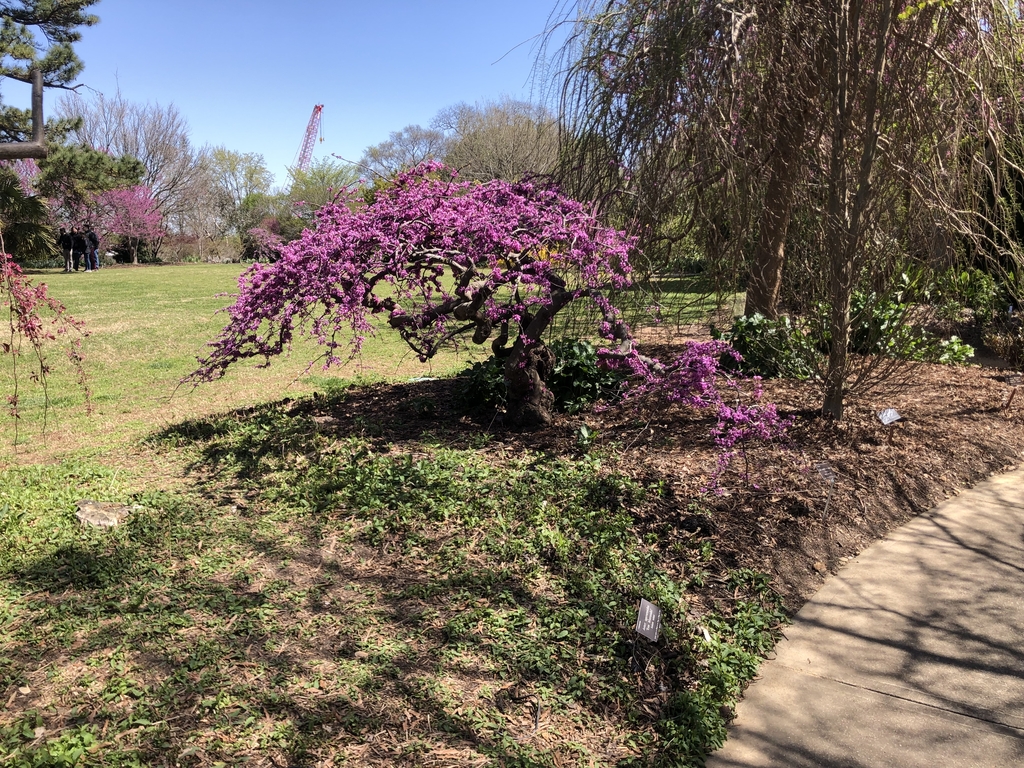Cercis canadensis var. texensis
Common Name(s):
Previously known as:
- Cercis occidentalis
- Cercis orbiculata
- Cercis reniformis
- Phonetic Spelling
- SER-sis kan-a-DEN-sis teck-SEN-sis
- Description
-
Texas redbud is a flowering, deciduous, multi-stemmed small tree in the bean family (Fabaceae). As the common name implies, it is native to central Texas up to southern Oklahoma. In the wild, plants generally appear singly, but they can form groups or thickets in riparian areas. The genus name Cercis comes from the Greek word kerkis, which means weaver's shuttle, referring to the fact that the seed pod resembles the size and shape of a weaver's shuttle used to move thread back and forth on a loom.
Texas redbud grows best in full sun to partial shade and on thin, calcareous, well-drained soils. It can grow in any type of soil as long as it is not acidic and is well drained, even occasionally dry. Reaching 25 to 30 feet in height and 15 to 25 feet in width, it is smaller and more drought tolerant than its eastern relative. In North Carolina, plant the eastern North America variety, as it is better suited to our hot humid summers. Propagate Texas redbud by seed.
It has showy, dark wine-red flowers that appear on bare stems in early spring and attract pollinators, butterflies, and hummingbirds. The seed pods are a food source for songbirds. Plant the tree as a specimen in a pollinator, butterfly, children’s, or drought-tolerant garden.
Insects, Diseases, and Other Plant Problems: Susceptible to caterpillars and scales. Crown rot, phytophthora, and root rot can also be a problem. It is resistant to armillaria. This tree can suffer from damage caused by deer.
VIDEO Created by Elizabeth Meyer for "Trees, Shrubs and Conifers" a plant identification course offered in partnership with Longwood Gardens.
- Profile Video:
- See this plant in the following landscape:
- Cultivars / Varieties:
- 'Oklahoma', 'Texas White', 'Traveller'
- Tags:


















- Cultivars / Varieties:
- 'Oklahoma', 'Texas White', 'Traveller'
- Tags:
-
-
Attributes:
- Genus:
- Cercis
- Species:
- canadensis
- Family:
- Fabaceae
- Uses (Ethnobotany):
- A fluid extract can be taken from the bark which is an active astringent used in the treatment of dysentery.
- Life Cycle:
- Woody
- Recommended Propagation Strategy:
- Seed
- Country Or Region Of Origin:
- Southern Oklahoma south to central Texas
- Distribution:
- OK, TX
- Wildlife Value:
- Nectar attracts pollinators such as butterflies, bumblebees, and orchard mason bees. It provides nesting materials for specialized bees. The leguminous seed pods are consumed by birds. Members of the genus Cercis support the following specialized bee: Habropoda laboriosa. Larval host to Henrys Elfin butterfly.
- Play Value:
- Attractive Flowers
- Attracts Pollinators
- Edible fruit
- Wildlife Food Source
- Edibility:
- The flowers are fried in Mexico. The flowers are acid and are sometimes pickled for salads. The nectar is of some value as a source of honey.
- Dimensions:
- Height: 20 ft. 0 in. - 30 ft. 0 in.
- Width: 15 ft. 0 in. - 25 ft. 0 in.
-
-
Whole Plant Traits:
- Plant Type:
- Tree
- Woody Plant Leaf Characteristics:
- Deciduous
- Habit/Form:
- Multi-stemmed
- Rounded
- Growth Rate:
- Medium
- Maintenance:
- Low
- Texture:
- Coarse
-
-
Cultural Conditions:
- Light:
- Full sun (6 or more hours of direct sunlight a day)
- Partial Shade (Direct sunlight only part of the day, 2-6 hours)
- Soil Texture:
- Clay
- Loam (Silt)
- Sand
- Soil pH:
- Alkaline (>8.0)
- Neutral (6.0-8.0)
- Soil Drainage:
- Good Drainage
- Occasionally Dry
- Available Space To Plant:
- 12-24 feet
- 24-60 feet
- USDA Plant Hardiness Zone:
- 6a, 6b, 7a, 7b, 8a, 8b, 9a, 9b
-
-
Fruit:
- Fruit Color:
- Brown/Copper
- Purple/Lavender
- Fruit Value To Gardener:
- Edible
- Display/Harvest Time:
- Fall
- Fruit Type:
- Capsule
- Fruit Length:
- 1-3 inches
- Fruit Description:
- 2- 4 inches long flattened seedpods with pointed ends, may remain on the tree into winter
-
-
Flowers:
- Flower Color:
- Pink
- Purple/Lavender
- Flower Value To Gardener:
- Showy
- Flower Bloom Time:
- Spring
- Flower Shape:
- Lipped
- Flower Petals:
- 4-5 petals/rays
- Flower Size:
- < 1 inch
- Flower Description:
- 1/2 inch wide pink to purple pea-shaped flowers in clusters of 4-10 grow from the bark and are very showy from March to April before the foliage appears.
-
-
Leaves:
- Woody Plant Leaf Characteristics:
- Deciduous
- Leaf Color:
- Green
- Leaf Feel:
- Glossy
- Deciduous Leaf Fall Color:
- Gold/Yellow
- Leaf Type:
- Simple
- Leaf Arrangement:
- Alternate
- Leaf Shape:
- Cordate
- Ovate
- Reniform
- Leaf Margin:
- Entire
- Hairs Present:
- Yes
- Leaf Length:
- > 6 inches
- Leaf Width:
- 3-6 inches
- Leaf Description:
- 4-8 inch by 2-4 inch thick glossy leaves heart to kidney shape without the pointed apex of the Eastern Redbud. The margins are wavy and undersides have some hairs. Yellow fall color is showy.
-
-
Bark:
- Bark Color:
- Dark Brown
- Dark Gray
- Surface/Attachment:
- Smooth
-
-
Stem:
- Stem Is Aromatic:
- No
-
-
Landscape:
- Attracts:
- Butterflies
- Hummingbirds
- Pollinators
- Songbirds
- Specialized Bees
- Resistance To Challenges:
- Drought








